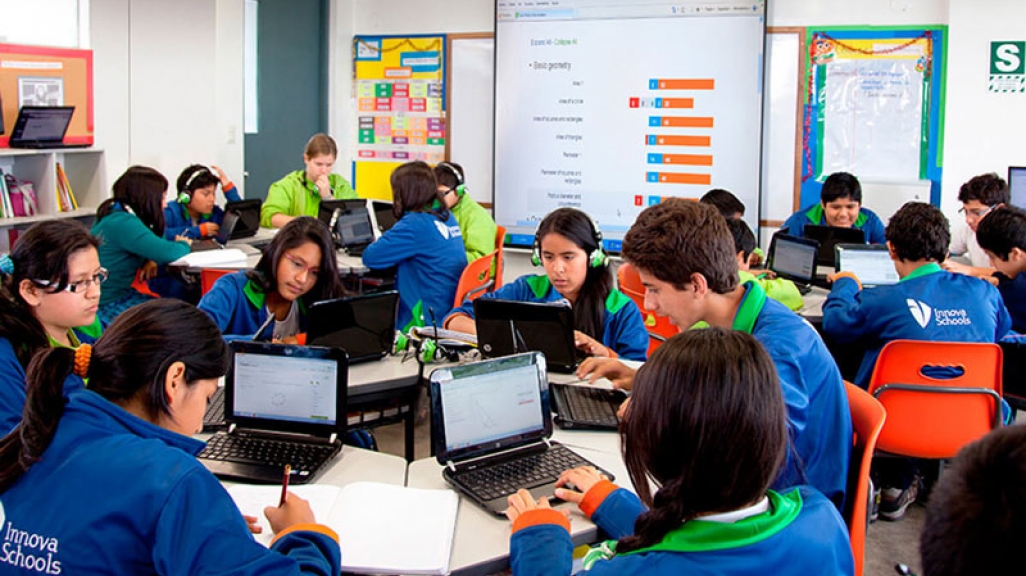The Case for Disruption in Latin America's Classrooms
The Case for Disruption in Latin America's Classrooms
Innovative solutions and new technologies can help the region leapfrog education challenges, writes AS/COA’s Susan Segal for weforum.org.
Many schools in Latin America – and in the U.S. and around the world – continue to use antiquated models for education that do not serve 21st century students. And students are paying the price. While there is now almost universal access to primary education in Latin America, the 40% that go on to graduate from the secondary level are not getting a quality education, and lag far behind their peers around the world. More than half of the students from the region did not achieve the minimum level of learning prescribed by the 2012 PISA. All eight Latin American countries that participated in the evaluation ranked in the bottom 20 of the 65 countries tested.
The way students learn and what they need to learn is rapidly changing. Kids today live and will work in a very different reality than when I was going through primary school – one that is fast-changing and technology-mediated. “To thrive in [our] innovation-driven economy,” begins the World Economic Forum’s latest education report, New Vision for Education, “workers need a different mix of skills than in the past. In addition to foundation skills like literacy and numeracy, they need competencies like collaboration, creativity and problem-solving and character qualities like persistence, curiosity and initiative.” Skilled jobs are increasingly concentrated on effectively analyzing information to solve problems. Technology is progressively replacing manual labour and pervading how we live and work.
Building the new competencies needed requires a re-conceptualization of learning—what it is and how it happens in an increasingly connected, digital world—so that kids are not learning by rote but are instead inspired to wonder, curious to discover, create, and build. This reconceptualization itself requires thinking out of the box.
In fact, some of the most interesting advances in education are coming from people outside the traditional education space. These new players are helping re-think yesterday’s educational model, using new technologies and big ideas. Many are already working with education ministries and schools, with highly encouraging early results.
Innova Schools in Peru, designed with help from global innovation firm IDEO, have incorporated “blended learning” into their model, which combines traditional classroom methods with individual, independent study delivered through online content. This method allows students to have control over the pace, time, and place of learning, and is thus more adaptable to the needs of each student. Innova students spend a portion of each day working through a challenge proposed by their teacher. In small groups, they sketch out solutions by using the Internet and physical handouts.
Another part of the day is dedicated to independent learning in front of a computer as students engage in lessons through programs such as Khan Academy, a personalized learning platform, which students begin to use in middle school. In both activities, the teacher acts as a guide through the exercise to encourage students, monitor their pace of learning, and offer advice on how and where to look for further resources. This kind of active learning uses technology to motivate students to search for answers and build knowledge themselves. Innova students are now outperforming their public school peers in Peru by double digits on the national exam.
Duolingo, created by a tech entrepreneur, is a platform that teaches language through gaming. Named Apple’s 2013 App of the Year, Duolingo has proven in a number of studies to be extremely effective in learning a new language. In 2012, the company began to tailor its app to schools, where it not only continues to motivate students to learn better than traditional methods, but also gives teachers a deeper look into individual student's learning needs. If a student consistently hesitates before answering a certain type of question, the teacher can identify that through the platform, and determine the areas where the student needs more practice. The government of Colombia recently adopted the programme for official use in public schools, as have the governments of Costa Rica, Guatemala, and parts of Brazil.
Scratch, a free programming language and online community developed by the MIT Media Lab’s Lifelong Kindergarten group, helps foster digital literacy and coding competency in students, allowing them to not only use but also understand the mechanics behind writing and creating new technologies. Today Scratch boasts more than 7 million users across the world that have shared over 10 million coding projects over its platform.
Innovative solutions and new technologies are emerging around the world—many from unlikely players—that hold the potential to help countries in Latin America leapfrog the most pressing challenges they face in education. The region has not yet effectively capitalized on these new technologies to improve learning. The sharing of best practices that are working in the region and across the globe will allow for a cross-fertilization that will bring Latin American schools into the 21st century.








